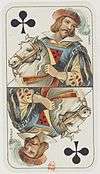Großtarock
| A trick-taking game of the Tarock card game family. | |
 | |
| Origin | Germany |
|---|---|
| Type | Trick-taking |
| Players | 3 |
| Cards | 78 |
| Deck | Tarot Nouveau |
| Play | Clockwise |
| Card rank (highest first) |
Trumps: Sküs, 21–1 ♣♠ K Q C J 10 – 2 A ♥♦ K Q C J A 2 – 10 |
| Related games | |
| Cego, Droggn, Troccas, Troggu | |
Großtarock or Grosstarock was a form of three-handed card game of the Tarock family which originated in Germany around 1760 and spread to the Netherlands and Scandinavia.[1] It only survives today as a variant in Denmark where it is called Tarok, but is also referred to as Danish Tarock.[1][2]
Cards
Großtarock was played with a French suited pack of 78 cards of the animal tarot type. These comprised:[3]
- Two black suits (Clubs and Spades) ranking as follows: K (high) Q C J 10 9 8 7 6 5 4 3 2 A (low)
- Two red suits (Hearts and Diamonds) ranking thus: K (high) Q C J A 2 3 4 5 6 7 8 9 10 (low)
- Twenty one Taroks as permanent trumps
- One unnumbered card, the Sküs, which excuses the player from following suit
Aim
The aim of Großtarock is to achieve the highest score in card points through taking tricks. The rules described are based on Dummett's description of the game 'as formerly played' and not the modern Danish version.[1]
Play
Großtarock is a three-hand game, and dealing and play are clockwise (unlike most of the Austrian Tarock games). Dealer distributes all the cards in packets of five, leaving himself with the last eight cards. He then discards three cards which must not include a King or Tarok 21. He must not discard any other Taroks unless he has the Pagat (Tarok 1) and no more than 2 others.[4]
Declarations
Beginning with the dealer, players may announce any of the following games:
- Ten or more Taroks – 10 game points + 5 game points for every Tarok over 10. Must state if the Sküs or Pagat are held.
- Three or more Matadors – for Sküs, Pagat, 21 and any Taroks in succession from 20 downwards. 10 points + 5 for every Tarok over 3.
- Three or more Kings – includes Sküs, Pagat and 21 as well as the 4 natural Kings.
- Cavallerie
- Four Queens, Cavaliers or Jacks
- Sixteen or more Ladons[5]
Playing
The player to the left of the dealer leads to the first trick; thereafter the winner of the trick leads to the next one. Players compete for tricks in clockwise order again. Tricks are won by the highest Tarok or, if no Tarok is played, the highest card of the suit led. The Sküs may not take a trick. Players must follow suit, but there is no compulsion to win a trick.[6]
Scoring
The card values for scoring purposes are:[7]
- Honours (Tarok 21, Pagat/Tarok 1, Sküs) – 5 points
- Kings – 5 points
- Queens – 4 points
- Cavaliers – 3 points
- Jacks – 2 points
- All others (the Ladons) – 1 point
Cards are grouped in threes, points totted up and two deducted per triplet. So a Queen, Jack and 7 count as 4+2+1−2 = 5. The whole pack thus contains 78 points.
References
- 1 2 3 Dummett 1980, p. 53.
- ↑ Furr 2009, p. 55.
- ↑ Dummett 1980, p. 54.
- ↑ Dummett 1980, p. 55.
- ↑ Dummett 1980, pp. 55–58.
- ↑ Dummett 1980, pp. 58, 59.
- ↑ Dummett 1980, p. 59.
Bibliography
External links
- Grosstarock rules
- Grosstarock (rules for Danish Tarock).